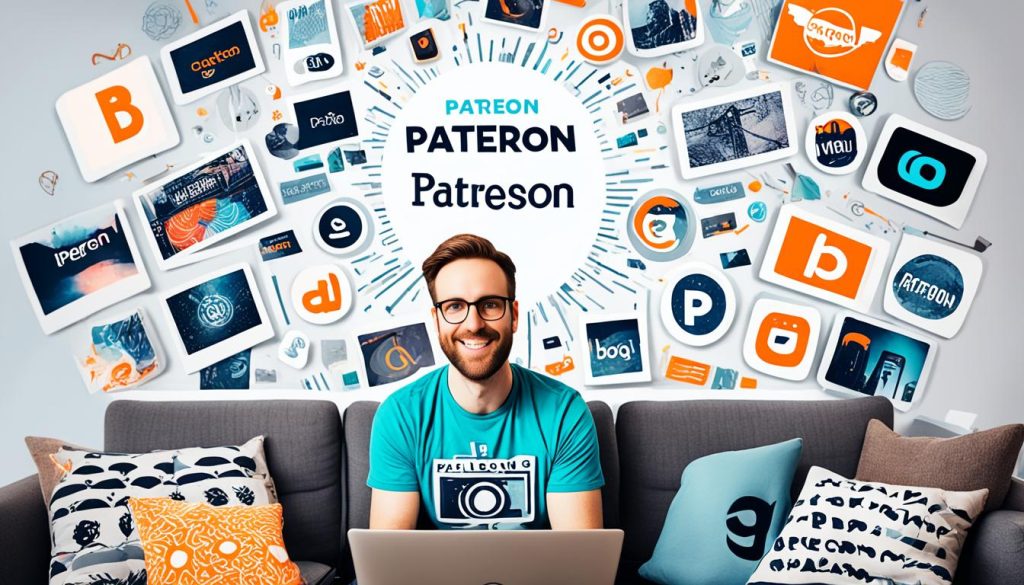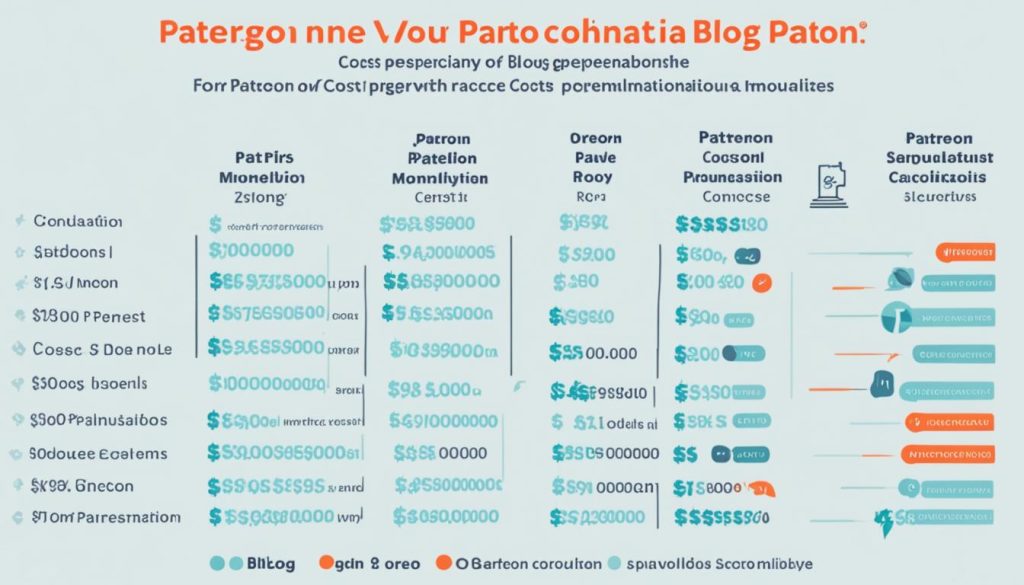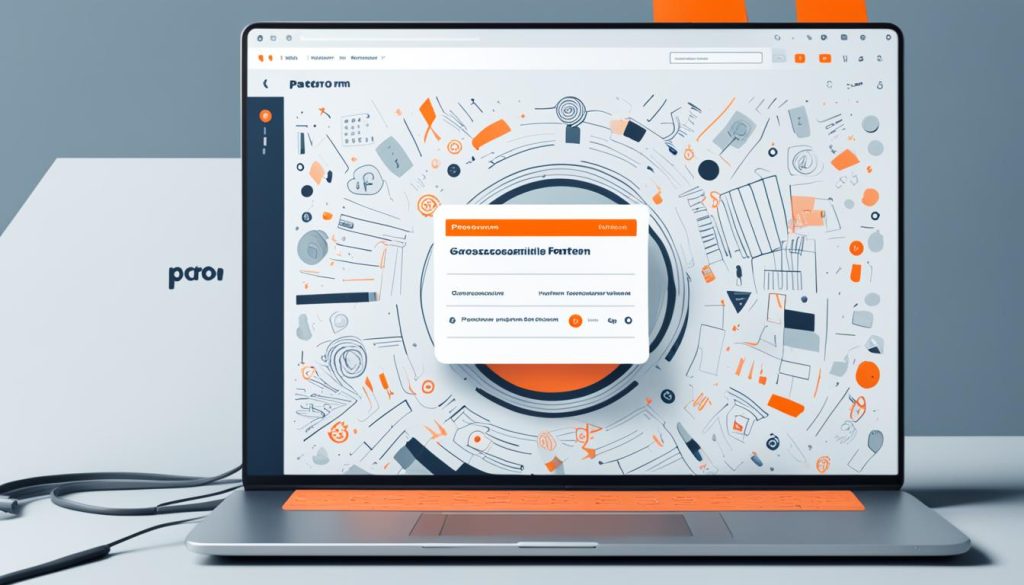Did you know over 200,000 creators on Patreon make a combined $2 billion a year from their fans? This shows how powerful Patreon is. It’s changed how content creators, like bloggers, make money. Traditional social media doesn’t always pay creators well, so Patreon is becoming a popular choice.
Patreon can give bloggers a steady income and a way to connect with fans. But, it has its downsides too. Knowing the good and bad of Patreon for your blog helps you decide if it fits your goals.
What is Patreon?
Patreon is a well-known crowdfunding platform for creators. It helps bloggers, artists, and other content creators earn money from a group of supporters, called “patrons.” The platform uses a membership-based monetization model. Creators give their patrons special subscription-based content and exclusive patron perks for monthly subscriptions.
Patreon’s Crowdfunding Model for Creators
Patreon’s main idea is a community-driven monetization model. Creators can set up different membership levels. Each level offers different access and special content. Patrons can then support their favorite creators by subscribing to these levels. This gives creators a steady source of income.
Key Features of the Patreon Platform
- Multiple membership levels with exclusive content and perks
- Secure payment processing and subscription management
- Patron-only communication channels and community features
- Analytics and insights to help creators understand their audience
- Tools for creating and delivering gated content to patrons
Patreon is a top platform for creators to make money. It helps writers, artists, and other creators earn a steady income. They do this with the help of their dedicated community of patrons.
Patreon blog monetization: Pros of Using Patreon for Your Blog
Patreon is great for making money from your blog because it offers a steady income. Unlike ads or sponsorships, Patreon gives you recurring revenue from loyal fans. This makes it easier to plan for the future.
Also, being a trusted crowdfunding platform helps you get more fans to pay for your work. People already know Patreon, so it’s easier for them to support you. This creates a strong community-based monetization around your blog.
Reliable Source of Recurring Revenue
Patreon’s model lets you have diversified revenue streams for your blog. This means you’re not just relying on ads or sponsorships. With a steady income from your fans, you can invest in growing your blog.
Familiarity and Trust in the Platform
Patreon is a well-known and trusted crowdfunding platform. This makes it easier to get your fans to support you. They’re already used to Patreon, so joining is easier for them. This helps build a strong community-based monetization around your blog.

Using Patreon’s strong brand helps you reach potential fans who are more likely to support you. This leads to a steady predictable monthly income and diversified revenue streams for your blog.
Creative Freedom and Community Nurturing
Patreon lets you have creative freedom for your blog. It’s different from other platforms with strict rules. Here, you can focus on building a community of loyal fans. You can try out new content ideas and monetization strategies without worrying about numbers.
With Patreon, you can connect directly with your biggest fans. This community-building opportunity is very valuable. It lets you make content that really speaks to your fans and meets their needs. This builds a loyal group that supports you and your work.
Patreon is great for testing different ways to make money. You can try out different membership levels, special content, or unique rewards. See what your fans like best. This helps you make your blog more profitable and valuable to your community.
Using Patreon’s creative freedom and focus on community can really help your blog grow. It lets you focus on making content your audience loves. And it helps you build a strong community around your blog.
Cons of Using Patreon for Blog Monetization
Patreon helps bloggers make money, but it has its downsides. One big issue is it’s hard to reach more people outside of your main fans. The way Patreon works mainly attracts your biggest supporters, which can slow down growing your blog’s audience and income.
Also, most Patreon creators make between $315 and $1,575 a month. This might not be enough for bloggers wanting to make a living from their blog. The small creator earnings make it tough to be financially stable just with Patreon.
Patreon focuses on a specific community, which is great for loyalty but bad for reaching new readers. This audience limitations can make it hard to grow your blog’s audience and impact.
In summary, Patreon can help bloggers earn money, but its limits in growing your audience and income should be thought over carefully. Bloggers should weigh their options for making a steady income.

Platform Fees and Pricing Issues
Patreon has a fee structure that can be a drawback for bloggers. Creators pay a commission of 5% to 12% on their Patreon earnings. There are also credit card fees that can go up to 4.4%.
These fees might not be a big deal when you’re just starting out. But as your Patreon income increases, they can take a big bite out of your earnings. Bloggers need to think carefully about whether Patreon’s fees are worth the steady income.
The way Patreon charges can make it hard to make a profit. The fees can be tough on small creators or those with a small audience. This can affect how much you can invest in your blog and grow your audience.
When looking at Patreon for making money from your blog, remember to consider the fees. Think about how these costs will affect your profits and your ability to keep growing your blog.

Lack of Customization and Branding Options
While Patreon is great for creators to meet their fans, its standard design might not work for bloggers wanting a unique look for their supporters. The platform’s branding capabilities are limited, making it hard for creators to stand out. This is key for keeping a paying audience that looks for a premium user experience.
Patreon’s standardized pages don’t offer much room for change. This makes it hard for bloggers to connect with their patrons and show off their unique audience engagement plans. Bloggers who have worked hard to build a strong brand identity online might find this frustrating.
The Limitations of a One-Size-Fits-All Approach
- Difficulty in creating a distinctive, branded experience for your supporters
- Inability to showcase your unique content and engagement strategies
- Potential loss of audience connection and loyalty due to the generic platform design

Bloggers who want to fully customize their online look and build a strong brand might find Patreon’s standard pages limiting. Looking into other platforms that offer more flexibility and branding options could be a better choice for them.
Removing the Evergreen Nature of Your Content
Using Patreon to make money from your blog has a big downside. It affects the evergreen nature of your content. Unlike YouTube, where your videos stay easy to find, Patreon’s feed hides older posts. This means you must always make new content to keep your fans interested.
This pressure to produce new content can hurt the long-term value of your blog. Instead of making quality, evergreen articles, you might just update often. This is to keep your content easy to find on Patreon.
For bloggers who want passive income and content discoverability, losing evergreen value is a big problem. As your old posts get pushed down in Patreon’s feed, fewer new readers will find your work. This can lower your long-term success and earnings.

The way Patreon is set up can hurt the evergreen nature of your blog. It puts a constant pressure to produce new content. This might affect how easy it is for people to find your work and its long-term value.
Patreon Controversies and Policy Changes
Patreon is a big deal for bloggers who want to make money from their work. But, it’s not without its problems and changes in rules that can affect how much money creators make and how happy users are. It’s key for bloggers to keep up with these issues if they count on Patreon a lot.
User Experience and Customer Support Issues
Creators have been talking about problems with using Patreon and getting help from the company. Some find it hard to use the platform, and others are upset with how their questions are handled. This is a big deal for bloggers who need Patreon to make money.
- Unclear or confusing platform features
- Slow or inadequate response from Patreon’s customer support team
- Lack of transparency around platform policy changes and their impact on creator earnings
To deal with these issues, bloggers should keep up with platform policy updates. They should watch how their earnings change and speak up for their needs. This helps keep a good user satisfaction and customer support quality.
By keeping informed and being flexible, bloggers can dodge the traps of Patreon. This way, they can make smart choices about how they make money in the long run.
Exploring Alternative Platforms: FanHero vs Patreon
Patreon is a top choice for creators to make money, but bloggers should look at FanHero too. This platform has many ways to make money and connect with fans. It’s great for building strong bonds with your audience.
FanHero’s Monetization and Engagement Features
FanHero is different from Patreon because it offers many ways for bloggers to make money. You can use subscriptions, pay-per-view, or sell digital products. This means you can find the best way to make money for your blog on FanHero.
Pricing and Transaction Cost Comparison
Looking at costs is important when choosing a platform. Patreon takes a 5-12% cut plus extra fees, but FanHero is cheaper, with costs as low as 2%. This could mean more money for your blog.
| Platform | Transaction Cost |
|---|---|
| Patreon | 5-12% + Payment Processing Fees |
| FanHero | As low as 2% |
By checking out FanHero, bloggers can find new ways to make money and save on costs. This could make their blogs more successful and profitable.
Choosing the Right Platform for Your Needs
When picking between Patreon, FanHero, or other platforms, bloggers should think about their content type and audience, monetization goals, and community engagement needs. They should look at the content they make, how much they want to interact with their audience, and their dreams of making their blog a lasting business.
Looking at the platform evaluation criteria for each option helps bloggers choose the best one for them. For example, if creating a close community is key, FanHero might be better than Patreon. On the other hand, if making steady money is the main goal, Patreon could be the better choice.
| Evaluation Criteria | Patreon | FanHero |
|---|---|---|
| Content Type and Audience | Suitable for a wide range of creators, from writers and artists to musicians and podcasters | Tailored for content creators looking to build a highly engaged community |
| Monetization Goals | Reliable source of recurring revenue through membership subscriptions | Flexible monetization options, including subscriptions, per-content pricing, and e-commerce |
| Community Engagement | Limited customization and one-design-fits-all approach | Advanced engagement features, such as live streams, exclusive content, and interactive polls |
By thinking about these factors, bloggers can pick the platform that fits their content type and audience, monetization goals, and community engagement needs. This helps them start a successful and lasting way to make money from their blog.
YouTube Channel Memberships vs Patreon
If you’re a blogger looking for ways to make money beyond ads, consider YouTube’s Channel Memberships. This feature lets you give special perks and content to your YouTube followers. It could be a new way to earn money without using a different platform.
Pros of YouTube Channel Memberships
- Leverage your existing YouTube audience: You can make money from the audience you’ve built on YouTube. You don’t need to ask them to join a service like Patreon.
- Simplified community management: YouTube has tools to help you manage your membership community. This makes it easier to connect with your biggest fans and share special content.
- Increased audience accessibility: Your YouTube followers can get to your membership perks right on the platform they’re already using. This means less hassle for them.
Cons of YouTube Channel Memberships
- Higher platform fees: YouTube takes a bigger cut of the money from Channel Memberships than Patreon does. This could affect how much you make overall.
- Limited customization options: YouTube’s Channel Memberships let you customize some things, but they don’t offer as much control as Patreon does. This might be a drawback for some creators.
- Restricted content ownership: Since you’re hosting your exclusive content on YouTube, you have to follow the platform’s rules. This could limit your control over your content and community in the long run.
Choosing between YouTube Channel Memberships and Patreon depends on what you need and who your audience is. Think about the good and bad points of each option to make a choice that fits your goals.
Making the Choice: Patreon or YouTube?
Choosing between Patreon and YouTube for your blog can be tough. Both have their own perks and downsides. The best choice depends on your platform selection factors, content distribution plans, monetization mix, and audience engagement goals.
Patreon lets you create a community of supporters for steady income. But, it might not reach as many people as you’d like. On the other hand, YouTube Memberships use your current followers and offer more ways to customize. Yet, you must follow YouTube’s rules.
Think about what you want from your audience, how you like to share your content, and your money-making goals. Look at the good and bad of each platform. Pick the one that best fits your audience and boosts your blog’s earnings.
| Factor | Patreon | YouTube Channel Memberships |
|---|---|---|
| Audience Reach | Limited | Leverages Existing Audience |
| Monetization Model | Recurring Revenue | One-Time Payments |
| Customization Options | Restricted | More Flexibility |
| Audience Engagement | Stronger Community | Depends on Channel Popularity |
The choice between Patreon and YouTube depends on what you need and want as a blogger. Weighing the pros and cons of each platform helps you make a choice that fits your content, community, and future plans.
Is Patreon Worth It for Your Blog?
Deciding to use Patreon for your blog depends on your needs, audience, and goals. Patreon can give you steady income and build a loyal community. But, it has limits on how many people you can reach, high fees, and limited customization options. These might stop you from making your blog a full-time business.
When looking at Patreon, think about other options like FanHero. They offer more flexibility and are cheaper for creators. By comparing Patreon with other choices, you can pick the best way to make money from your blog.
Choosing Patreon means balancing its good points with its downsides. Think about what you really need and look at different options. This way, you can decide if Patreon is right for you or if another platform is better for your blog’s future.

